Canned fish yassification, preserving tradition & the vilification of “unskilled” labour
Or what ELSE I thought whilst visiting a sardine cannery
After writing last week’s story “Are these the best canned sardines in the world,” I realised I had so much more to say about canned fish. Or more accurately, I had so much more to say about what canned fish made me think about.
That’s what this week’s story is — a deeper dive into wider issues.
I’m keeping this behind the paywall for my lovely cohort of paid subscribers. You can support the work I do at The Sauce, join the party and get access to everything past, present and future for $5 a month or $50 a year:
25,000 cans a day.
That’s what the 100 women (and 12 men) working the factory floor of the Pinhais cannery in Porto pack per day.
It’s a lot, but what struck me most about this number is that, as I mentioned last week, the workers don’t have a quota. That’s not how this cannery works because they are less interested in squeezing every last cent out of their workers than they are preserving quality and tradition.
As expected with last week’s cannery visit, I came away with better knowledge of how fish is canned. I also came away with more than that.
I came away thinking about the recent gentrification or yassification of canned fish and the small-washing (the practice of branding large-scale food as small and artisanal) that comes with it.
I came away thinking about how important food companies are when they go against our modern-day preoccupation with profits-at-all-costs.
As I touched on last week, I came away thinking about how easy it is to dismiss factory workers as unskilled labour when these women of industry are anything but.
Most importantly, I came away thinking that these thoughts are exactly why the preservation of old-school, quality-focused food production across the world is so important.
Keep reading with a 7-day free trial
Subscribe to The Sauce to keep reading this post and get 7 days of free access to the full post archives.




